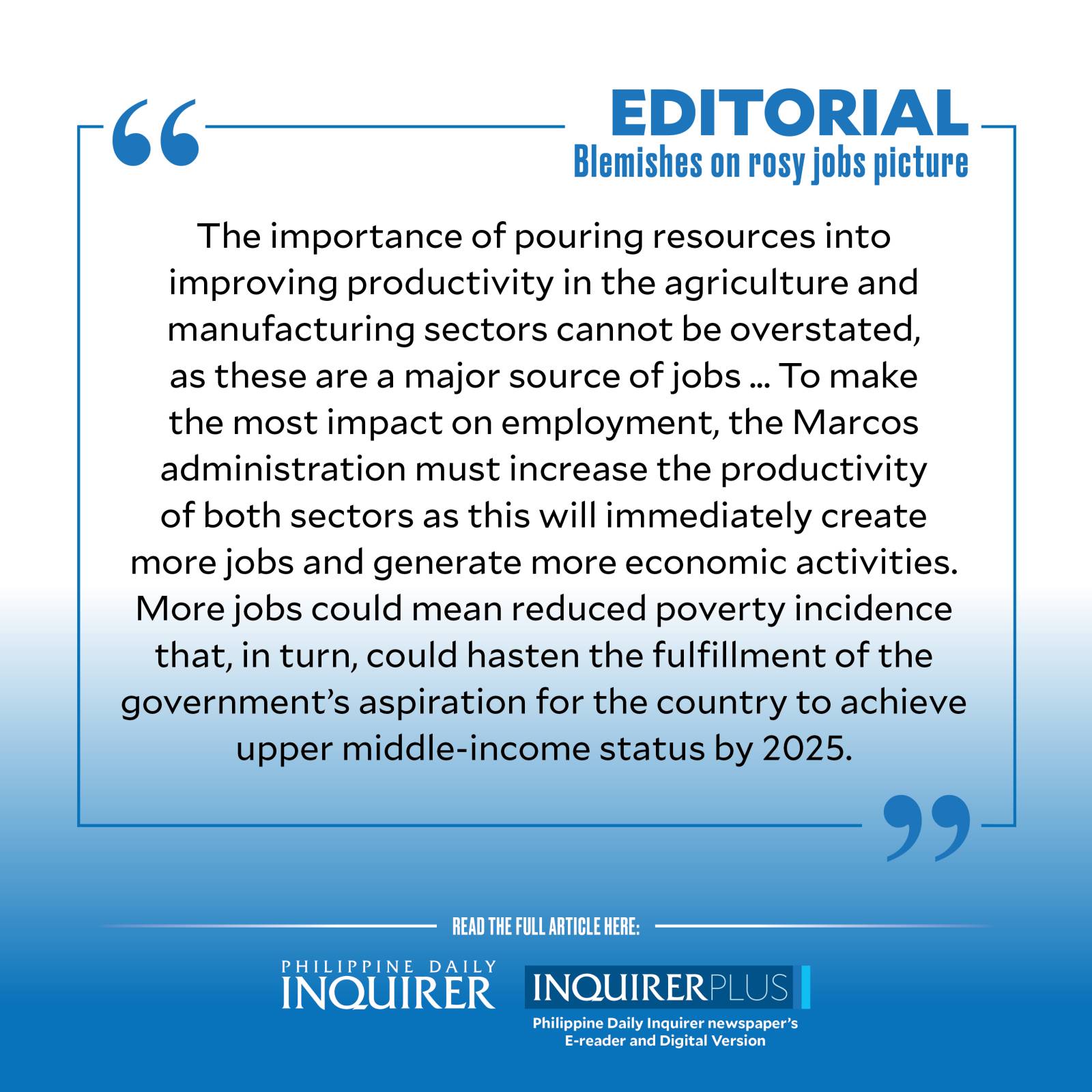Blemishes on rosy jobs picture
Some 50,000 Filipinos will likely have a bleaker Christmas this year after losing their jobs in September, and swelling the ranks of the unemployed to 2.26 million. This has led to a slight increase in the country’s jobless rate from 4.4 percent in August, to 4.5 percent in September.
The uptick can be blamed on a host of factors, including the surge in rice and fuel prices that have dampened spending and investments by households and the private sector. Then there’s the onset of the so-called ghost month during which a number of private firms dialed back expansion plans.
Article continues after this advertisementBut zooming out of the month-on-month movement will reveal a better picture, as unemployment numbers significantly declined from September last year, with 234,000 more Filipinos finding jobs—a strong indication of the economy’s continuing recovery from the ravages of the COVID-19 lockdown. As pointed out by Michael L. Ricafort, chief economist of Rizal Commercial Banking Corp., the unemployment rate was in “the best levels since the pandemic started, and also among the best levels in about 18 years or since 2005.” It remains “one of the major bright spots [in] the economy.”
Even more notable was the drop in the underemployment rate, from 11.7 percent in the previous month to 10.7 percent, a massive improvement from the 15.4 percent level in September last year. This means more Filipinos now hold a full-time job. Overall, the country’s employment rate improved to 95.5 percent last September, from 95 percent in the same month in 2022, which shows that 47.7 million Filipinos were employed, 83,000 more than during the same period last year.
Even better, the proportion of workers in middle- and high-skill, and therefore better paying jobs, rose to 57.3 percent from 57.1 percent in September 2022, and to 14.7 percent from 14.2 percent, respectively. Conversely, “elementary occupations” that consist of simple and routine tasks requiring use of hand-held tools and some physical effort showed the biggest drop in employment year-on-year. This, according to national statistician Claire Dennis Mapa was a “good indicator” of the improving quality of jobs in the Philippines.
Article continues after this advertisementA closer look at the numbers, however, reveals blemishes on an otherwise rosy picture. The labor participation rate, for instance, is just 64.1 percent, equivalent to 49.93 million Filipinos aged 15 or older who are either working or looking for work, a decline from 65.2 percent in the same period last year. This was among the lowest levels since June 2023 and May 2022, maybe because more working-age Filipinos have removed themselves from the workforce due to lack of prospects or force of circumstance.
This partly explains why the drop in the labor participation rate was more severe among women. The National Economic and Development Authority (Neda) has rightly expressed concern that women looking for gainful employment comprise only 53.4 of the eligible pool in September 2023. This is lower than the 54.8 percent recorded in the same period last year, and significantly lower than the 74.7 percent participation rate for men. Household duties were identified among the main causes for the decline, an indication that women still bear the disproportionate burden of taking care of the home, preventing them from taking on a full-time job despite being qualified for it.
It is encouraging that Neda Secretary Arsenio Balisacan has recognized this reality, and said that government would promote programs to arrest the declining labor force participation rate among women. These include encouraging the adoption of wider alternative work arrangements so that women can remain productive even from the confines of their home.
Aside from the lower representation of women in the labor pool, the Philippine Statistics Authority noted that year-on-year, the biggest job losses were seen in manufacturing, wholesale and retail, and agriculture and forestry. These high-impact sectors that traditionally provide stable or more long-term jobs to Filipinos in the countryside have been hobbled by increased borrowing and operating costs due to the spike in interest rates and stubbornly high inflation. Fears are mounting that the vital agricultural sector will shed even more jobs in succeeding months, with El Niño causing extended dry spells that deplete farm output. The importance of pouring resources into improving productivity in the agriculture and manufacturing sectors cannot be overstated, as these are a major source of jobs. As Ricafort underscored, these sectors account for as much as 40 percent of total jobs in the country.
Which means that to make the most impact on employment, the Marcos administration must increase the productivity of both sectors as this will immediately create more jobs and generate more economic activities. More jobs could mean reduced poverty incidence that, in turn, could hasten the fulfillment of the government’s aspiration for the country to achieve upper middle-income status by 2025.
















